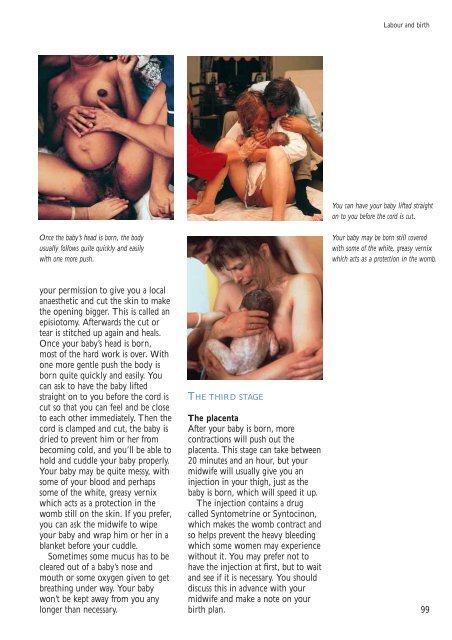here - Health Promotion Agency
here - Health Promotion Agency
here - Health Promotion Agency
Create successful ePaper yourself
Turn your PDF publications into a flip-book with our unique Google optimized e-Paper software.
Labour and birth<br />
You can have your baby lifted straight<br />
on to you before the cord is cut.<br />
Once the baby’s head is born, the body<br />
usually follows quite quickly and easily<br />
with one more push.<br />
Your baby may be born still covered<br />
with some of the white, greasy vernix<br />
which acts as a protection in the womb.<br />
your permission to give you a local<br />
anaesthetic and cut the skin to make<br />
the opening bigger. This is called an<br />
episiotomy. Afterwards the cut or<br />
tear is stitched up again and heals.<br />
Once your baby’s head is born,<br />
most of the hard work is over. With<br />
one more gentle push the body is<br />
born quite quickly and easily. You<br />
can ask to have the baby lifted<br />
straight on to you before the cord is<br />
cut so that you can feel and be close<br />
to each other immediately. Then the<br />
cord is clamped and cut, the baby is<br />
dried to prevent him or her from<br />
becoming cold, and you’ll be able to<br />
hold and cuddle your baby properly.<br />
Your baby may be quite messy, with<br />
some of your blood and perhaps<br />
some of the white, greasy vernix<br />
which acts as a protection in the<br />
womb still on the skin. If you prefer,<br />
you can ask the midwife to wipe<br />
your baby and wrap him or her in a<br />
blanket before your cuddle.<br />
Sometimes some mucus has to be<br />
cleared out of a baby’s nose and<br />
mouth or some oxygen given to get<br />
breathing under way. Your baby<br />
won’t be kept away from you any<br />
longer than necessary.<br />
THE THIRD STAGE<br />
The placenta<br />
After your baby is born, more<br />
contractions will push out the<br />
placenta. This stage can take between<br />
20 minutes and an hour, but your<br />
midwife will usually give you an<br />
injection in your thigh, just as the<br />
baby is born, which will speed it up.<br />
The injection contains a drug<br />
called Syntometrine or Syntocinon,<br />
which makes the womb contract and<br />
so helps prevent the heavy bleeding<br />
which some women may experience<br />
without it. You may prefer not to<br />
have the injection at first, but to wait<br />
and see if it is necessary. You should<br />
discuss this in advance with your<br />
midwife and make a note on your<br />
birth plan.<br />
99

















